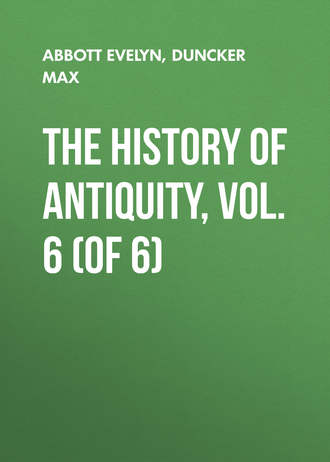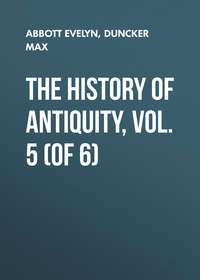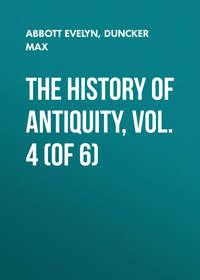 полная версия
полная версияThe History of Antiquity, Vol. 6 (of 6)
244
"Pers." 555, 644, 654, 852 ff. 900.
245
Herod. 3, 92-94, 97; 7, 78, 79. Xenoph. "Anab." 5, 4; 7, 8. Arrian ("Anab." 3, 11) mentions Albanians in the army of the last Darius.
246
Herod. 4, 44.
247
Vol. IV. 384.
248
Exc. Vatic. p. 35 = 10, 19, 5.
249
Herod. 3, 139, 140.
250
Herod. 3, 141-149. Paus. 7, 5, 4, ff. Heracl. Pont. Fragm. 10, ed. Müller.
251
Herod. 4, 138.
252
Ctes. "Pers." 16.
253
At a later time Xerxes caused Sataspes to sail round Africa.
254
Herod. 4, 1.
255
Herod. 4, 85, 87.
256
360 triremes and penteconters were used for the bridge of Xerxes. Herod. 7, 36.
257
Herod. 4, 87.
258
Polyb. 4, 39.
259
Strabo, p. 319, 320. Opposite the temple of the Chalcedonians on the mouth of the Pontus, which was sacred to Zeus Urias (now Anadoli Kavak), there lay on the European shore also on the mouth of the Pontus a temple of the Byzantines which later authors call the Serapeum (now Rumili Kavak). Scyl. "Peripl." 67.
260
Herodotus allows the Bosphorus a breadth of four stades; Strabo in one passage mentions four, in another five; p. 125, 319. Modern authors do not agree in their measurements (Grote, "Hist. of Greece," 5, 26), but give about 1¼ mile, i. e. above 5000 feet for the narrowest part, and five miles for the widest. For the narrowest place most authorities allow about 3900 feet, i. e. 6½ stades; cp. Kruse, on Herodotus' measurement of the Pontus, s, 41. On the other hand, Moltke ("Briefe," s. 82) gives the following: At the northern mouth between the light-houses, 4166 paces; at Tell Tabia, 1497 paces; between the castles, 958 paces.
261
"Anapl. P. E." frag. 35. Choerilus, in Strabo, p. 303.
262
Herod. 4, 88.
263
The chronology of the conquests of Darius is not easy to fix. In Herodotus the campaign against Samos is contemporaneous with the rebellion of the Babylonians (3, 150). If Darius had had armies at his disposal from Samos there, he would not have needed to send Bagaeus. The expedition to Samos must be placed after the end of the rebellion, i. e. at the earliest in the year 517, and it cannot be put later than a year at the least before the Scythian expedition, since the ships of Samos, led by Syloson's son, take part in that expedition, and in addition to Samos the cities of the Bosphorus are in the hands of the Persians before that event. The expedition to investigate the shores of Greece, in which Democedes took part, is placed by Herodotus before the attack upon Scythia. This is improbable, because the experience which Darius gained in the Scythian expedition, and which made it seem desirable to put the command in Persian hands, preceded this expedition. There is nothing to point to it before the expedition; it first becomes intelligible when Darius had resolved to change his plan of conquests in the north for conquests in the west, and had given Megabyzus orders to subjugate the coasts of Thracia on the Ægean, – when Megabyzus had advanced to the Strymon and Macedonia had recognised the sovereignty of Persia. On the other hand, the investigation of the Greek coasts cannot be put much later than 512, since Milo of Crotona, who is still of great influence in that region, as Herodotus himself remarks (3, 137), betroths his daughter to Democedes. This influence Milo retained only as far as the year 510 or 509; for soon after the victory over Sybaris and the destruction of the city, which took place 511 or 510 B.C., the rising against Pythagoras and the aristocracy took place; they were overthrown and expelled. In Herodotus the Scythian expedition comes after the capture of Babylon (4, 1). We have seen from the inscriptions (p. 254), that there were two rebellions of Babylon, and that they cannot have come to an end before the close of the year 517. Now Samos was subjugated before this Scythian expedition; moreover Byzantium and the Chersonese must have been in the hands of the Persians; at least a year must have been occupied with the preparations required to bring 700,000 men to the Bosphorus, and with the preparations for building the bridge (Herod. 3, 83). Hence the campaign cannot have commenced before the year 515 B.C. and it cannot be put later than 510 B.C. Miltiades is already master of the Chersonese when Darius crosses the Danube; according to Herodotus it is the Pisistratids (not Hippias) who sent him there. Hence Miltiades was master of the Chersonese before 514 B.C., the year in which Hipparchus was murdered. Again, when Miltiades has to retire from the Chersonese before the return of Darius, he does not go to Athens, from which it follows that Hippias was still tyrant in Athens. Thucydides tells us that when Hippias, after the murder of Hipparchus, was looking about for alliances he married his daughter to Aeantides, the son of Hippoclus, tyrant of Lampsacus, because he saw that Hippoclus was in great repute with Darius. This influence Hippoclus must have gained in the Scythian expedition; he led the ships of his city to the Danube and voted for remaining there. Hence this expedition must be put some time before 510 B.C. If we allow two years for the battles of Megabyzus in Thrace, and the march of Bubares to Macedonia after the Scythian war, and place, as is natural, the expedition to the coasts of Hellas, which falls in the year 512 B.C., after these acquisitions, we might keep to the year 515 for the Scythian expeditions. But as the Indian conquests precede the Scythian war, the year 513 B.C. seems still better. The expedition to Barca is, in Herodotus, contemporaneous with the conflicts of Megabyzus against those "who were not of Median opinions" (4, 145). This contemporaneous date is supported by the fact that Greek ships only, and not Phenician, are ordered to the Danube, and to support the communications of Megabyzus with Asia, – a circumstance which is best explained by the absence of the Phenicians in the African expedition. Moreover, Justin (19, 1) speaks of an embassy of Darius to Carthage at the time when this city was engaged in a conflict with Doreus of Sicily (Herod. 5, 45-48; 7, 165; Diod. 4, 23). Such an embassy, which could only be sent to demand a recognition of supremacy or union in war against the Greeks, was first suggested when the Persians reached as far as the Euhesperides and Persia became a neighbour of Carthage, i. e. after the expedition to Barca. The colony of Dorieus on the Eryx was planted between 510 and 508; he had previously taken part in the battle on the Traeis in 311 or 510 B.C. The embassy of Darius to Carthage would therefore be subsequent to the campaign to Barca and the expedition of Democedes, and the years 513 and 512 seem most suitable for the first. From the inscriptions of Darius it is clear that the inscription of Persepolis, when compared with the inscription of Behistun, enumerates more subject lands. The former speaks of the Ionians of the continent and the Ionians of the sea (daraya), while the inscription of Behistun merely mentions the Ionians. By the Ionians of the sea we are to understand the newly-subjugated Greeks of Samos, the Greek cities on the Bosphorus and Propontis. Moreover, the inscription of Persepolis, as already mentioned, speaks of Idhus (p. 260), while the inscription of Behistun speaks of Gandaras only. It follows from this that the first undertakings of Darius after crushing the rebellion were the wars in the east, the conquests of Samos and the Greek cities on the straits. This is established by the statement of Herodotus that the Indians were included in the first division into satrapies – which he places soon after the accession of Darius – but the islands and the Thracians were added later on. The palace at Persepolis must therefore have been built about the year 515 B.C. after the war upon the Indians and the expedition to Samos, after the subjugation of the strait, but before the campaigns against Scythia and Barca. The Scythian campaign falls in the year 513, the conquests of Megabyzus and Otanes in 512, the campaign against Barca in 513 and 512, the expedition for the investigation of the Greek coasts in 512 or 511. The inscription on the tomb of Darius does not mention Ionians of the continent and Ionians of the sea, but Ionians merely in one case, and then Yauna takabara, i. e. Ionians who wore locks, by whom may be meant the Greeks of Lemnos and Imbros, the Greek cities of the Thracian coast, and the Macedonians, i. e. the regions which were first subjugated after the Scythian campaign. It will be made clear below that the last names in the inscription on the tomb are to be explained of African tribes, i. e. of the result of the expedition against Barca. By the Çkudra, mentioned on the inscription, we may understand the Thracians; in the place of the Çaka who are mentioned without any addition at Behistun and Persepolis, the sepulchral inscription has three kinds of Çaka: —Çaka humavarka, who must be interpreted to mean the Amyrgian Sacae of Herodotus; Çaka tigrakhauda, i. e. Sacae with pointed caps; and finally Çaka taradaraya, i. e. Sacae beyond the sea, who must be the Scoloti.
264
Herod. 4, 89-91.
265
Herod. 4, 90-92. "Geographical Journal," vol. 24, p. 44 ff, where is also to be found the report of General Jochmus on the supposed inscription in cuneiform letters and on the stone-heaps, which, according to Herodotus, the soldiers of Darius piled up at Artiscus.
266
Herod. 4, 93, 94; Strabo, p. 305; Thuc. 2, 96.
267
Herod. 4, 97, 98.
268
Vol. III. 235. Neumann, "Hellenen in Skythenlande," s. 200, 211, 215.
269
Vol. III. 229.
270
Neumann, loc. cit. s. 223 ff.
271
Justin, 2, 3, 5.
272
Ctes. "Pers." 16.
273
Strabo, p. 305.
274
Strabo, p. 737.
275
Pherecyd. fragm. 113, ed. Müller.
276
Hic quum crebri afferrent nuntii male rem gerere Darium premique ab Scythis, Miltiades hortatus est, etc. Nepos, "Miltiades," 4, in any case following Ephorus.
277
Herod. 5, 27. It is clear that the Antandrians and Lamponians were accused only of abandoning the campaign, not of imperilling the retreat.
278
Strabo, p. 591.
279
Herod. 5, 11.
280
Herod. 4, 143, 144.
281
Herod. 5, 12.
282
Herod. 5, 26, 27.
283
Herod. 5, 12, 23, 25. The chronology which Herodotus thus gives to the campaign of Otanes, representing it as subsequent to that of Megabyzus, is impossible. He himself represents Otanes as nominated general of the forces on sea, and only subsequently as a successor of Megabyzus. The subjugation of the cities belongs to his first command.
284
Herod. 6, 40, 84.
285
It is self-evident that Miltiades did not wait for the arrival of Darius on the Danube.
286
According to Polyaenus, Chalcedon was taken by a mine, which was carried from a hill 15 stades from the city under the market-place. "Strateg." 7, 2, 5. It is obvious that we must read Καλχηδών here, and not Καρχηδών. The altar of Zeus Diabaterius which, according to Ctesias, Darius erects, and the Chalcedonians subsequently pull down, is certainly identical with the two monuments which, according to Herodotus, Darius set up at Byzantium (above, p. 269). Herodotus also speaks of the destruction of the monuments, but ascribes it to the Byzantines. This was done obviously in the time after the battle of Mycale; if previously destroyed they would have been restored by Megabyzus and Otanes when they subjugated the Hellespont. Of the later destruction Herodotus relates that the Byzantines conveyed the stones into the city, and used them in building the altar of Artemis Orthosia; one stone only, covered with Assyrian letters, was left at the temple of Dionysus: Herod. 4, 87.
287
De Rougé, "Revue Archéolog." 8, 51, 52. De Rougé has Aram, Brugsch now reads Elam ("Hist. of Egypt," 2, 297), and translates: "For he also was the great lord of all lands and a great king of Egypt, – in order that I might reinstate the number of the sacred scribes of the temples, and revive whatever had fallen into ruin. The foreigners escorted me from land to land, and brought me safe to Egypt, according to the command of the lord of the land. I did according to what he had commanded. I chose them from all their (?) of the sons of the inhabitants – to the great sorrow of those who were childless – and I placed them under expert masters, the skilful in all kinds of learning, that they might perform all their works. The king did all this – in order to uphold the name of all the gods, their temples, their revenues, and the ordinances of their feasts for ever."
288
Herod. 2, 110; Diod. 1, 50, 95. For Rach-num-hat which he read previously Brugsch now reads Chnum-ab-rha. "Hist. of Egypt," 2, 299.
289
Mariette, "Athen. Franç." 1855; Mai, p. 48.
290
The remark in Polyaenus; Darius marching through Arabia against the Egyptians who rebelled against the tyranny of Aryandes, had again gained their affection by offering a prize of 100 talents of gold to the discoverer of a new Apis in the place of that which had just died, cannot be referred to the Apis which died in the year 518 B.C. In that year Darius was fighting in Media against Phraortes, Aryandes was satrap in the year 512 B.C. and long after. Hence it must refer to the second Apis, which appeared in 491 B.C., the thirty-first year of Darius, for which Darius caused a sepulchre to be built. That the first rebellion of the Egyptians against Darius took place about this time follows from a chapter in Aristotle's "Rhetoric," 2, 20, where we are told that Darius did not cross over to Hellas before he had reduced Egypt; and in like manner Xerxes reduced Egypt before crossing over to Hellas. The "crossing over" can only refer to the campaign of Datis and Artaphernes; the first rebellion of Egypt against Darius therefore took place just when the rebellion of the Ionians had been crushed, i. e. 492, 491 B.C.; the second occurred in 486 B.C.
291
Herod. 4, 145 says, "at the same time when Megabyzus subjugated the inhabitants of the Hellespont." This subjugation would begin in the autumn and pass over into the next spring.
292
Herod. 4, 167. Above, p. 152.
293
Herod. 4, 164, 200.
294
Herod. 4, 165, 167, 197.
295
Herod. 4, 200-204; Heracl. Pont. fragm. 4, ed. Müller.
296
Herod. 4, 203, 204.
297
Herod. 4, 163; Heracl. Pont. Fragm. 8, ed. Müller; Pindar, "Pyth." 4, 5 and the Scholia.
298
Herod. 3, 91.
299
Herod. 7, 71.
300
In Brugsch, "Hist. of Egypt," 2, 297, Settu-Ra.
301
Lepsius, "Inschriften von Charigeh und Dachileh, Z. f. Aeg. Spr." 1874, s. 75, 78.
302
It seems to me rash to find Carthage in Karka (so also in the Babylonian version) with Oppert ("Journal Asiatique," 1872, p. 163 ff.), and Mordtmann ("Z. D. M. G." 16, 110).
303
Justin, 19, 1.
304
Though I admit that negotiations may have taken place between Darius and the Carthaginians, I do not at the same time allow the accuracy of the statement in Diodorus about the league of Xerxes and the Carthaginians against the Greeks: a Sicilian may be suspected of ascribing to his countrymen as large a share as possible in the glory of the Persian war.
305
Herod. 5, 16.
306
Herod. 5, 26.
307
Herod. 7, 59.
308
Herod. 5, 11, 23.
309
Herod. 8, 139; Thuc. 2, 99, 200.
310
Herod. 5, 19.
311
Herod. 5, 21; 7, 21; Justin, 7, 3, 4.
312
Herod. 5, 18, 21; Justin, 7, 3, 4. In the year 512 B.C., in which this incident falls, Alexander must have been very young; Herodotus speaks of him as young and inexperienced. In Justin we are told in reference to the length of his life: "Senex decessit." On the reigns of Amyntas and Alexander Philhellen, I shall treat in my Greek History. For the present I refer to Droysen, "Hellenismus," 12, 75, and Von Gutschmid, "Ueber die makedonische Anagraphe, Symbol. Philolog." Bonn.
313
The Ionian revolt liberated Lemnos from the dominion of the Persians; when Miltiades during the revolt subjugated Lemnos and Imbros to Athens, Hermon was at the head of Lemnos.
314
Herod. 3, 129-138. Athenaeus, p. 522. On the date of the expedition above, p. 270, n. That this whole expedition owed its origin to an intrigue of Democedes, is merely a part of Herodotus' love of anecdote. But it is not incredible that Democedes joined it in the hope of returning to Greece.
315
Herod. 7, 55; 8, 113; 9, 31. Xenoph. "Cyri Instit." 8, 3, 10, 25.
316
"Laws," p. 695. Vol. V. 390 n. 2.
317
Xenoph. "Cyri Instit." 8, 1, 5, 6, 17-20.
318
Xenoph. "Cyri Instit." 8, 1, 33.
319
Xenoph. "Cyri Instit." 8, 1, 11.
320
Xenoph. "Cyri Instit." 8, 1, 9.
321
Xenoph. "Cyri Instit." 8, 1, 40; 8, 2, 7-9.
322
Xenoph. "Anab." 1, 9, 25; "Cyri Instit." 8, 2, 3.
323
Herod. 3, 130. 8, 118; Ctes. "Pers." 22; Xenoph. "Cyri Instit." 8, 3, 3, 4; "Anab." 1, 2; Plut. "Artaxerxes," c. 10-14.
324
Herod. 1,134; Xenoph. "Anab." 1, 9, 31; "Cyri Instit." 8, 3, 13; Arrian, "Anab." 7, 11; Curtius, 3, 3, 19.
325
Herod. 1, 136; Xenoph. "Cyri Instit." 1, 2, 13; 8, 8, 7; Strabo, p. 733.
326
Nicol. Damasc. fragm. 67, ed. Müller; "Laws," p. 695.
327
"Alcib. I." p. 121, 122.
328
Plut. "Artax." c. 3.
329
Xenoph. "Anab." 1, 9.
330
Xenoph. "Cyri Instit." 8, 8, 13.
331
Themistocles also was instructed in the doctrine of the Magians, when he was trained for a place at the Persian court; Plut. "Themist." c. 29.
332
Strabo, p. 733, 734.
333
Xenoph. "Cyri Instit." 8, 1, 33; 8, 6, 10, 13, 14. Plut. "Artax." c. 5, 24.
334
Xenoph. "Anab." 1, 9, 3.
335
Nöldeke, "Tabari," s. 389, 443.
336
G. Smith, "Discoveries," p. 387, 388; Boscawen, "Transactions Bibl. Arch." 6, 61 ff.
337
Above, p. 109.
338
Mariette, "Athen. Franç,." May, 1855, p. 48; Brugsch, "Hist. of Egypt," 2, 291. Above, p. 301, n. 3.
339
Haggai i. 4, 10; ii. 16-20; Zechariah vi. 11-13.
340
Zechariah ii. 4, 5; viii. 23.
341
Ezra c. vi.; Psalm lxvi. appears to refer to this.
342
Nehemiah i. 3.
343
In the three lists of nations in the inscriptions of Darius, Syria and Phenicia are not specially mentioned; they must be included in the names Babylonia and Arabia; in the same way Lydians, Phrygians, Carians, and Mysians are included in the name Çparda, i. e. Sardis.
344
Behistun, 3, 11 ff.
345
The inscription of Behistun specially designates Arachosia and Bactria as satrapies, 3, 13, 14, 54, 55.
346
Herodotus (3, 89) places this arrangement into satrapies immediately after the accession. This is impossible, owing to the rebellions, which continued down to the year 517 B.C. But from the fact that Herodotus includes the Indians in this arrangement, and represents the Thracians and the islands as added subsequently (3, 94, 96), we may conclude that it was made after the Indian conquests and before the successes of Megabyzus and Otanes, i. e. about 515 B.C. The arrangement of Darius was not retained without changes. Babylonia and Assyria were afterwards separated; Babylonia formed one satrapy, Syria and Assyria a second, Phoenicia and Arabia a third. The satrapy of the Ionians revolted after the battle of Mycale; in the Peloponnesian war, we find, as in the time of Cyrus, two satrapies in hither Asia, Sardis and Dascyleum. Xenophon ("Anab." in fine) enumerates six satrapies in Asia Minor: Lydia, Phrygia, Bithynia, Paphlagonia, Cappadocia and Lycaonia, Cilicia. Arrian, ("Anab." 1, 12) enumerates five: Phrygia on the Pontus, Greater Phrygia, Lydia, Cappadocia, Cilicia; and, finally, in these later periods several satrapies were united in one hand.
347
Above, p. 110. Xenoph. "Cyri Instit." 8, 6, 1, 9, 10; Curtius, 5, 1, 20. There is no doubt that the satraps commanded the troops of their districts; at a later time they even carried on independent wars. That the garrisons of the fortresses were bound to obedience follows from Herod. 3, 128. The limitations, which Xenophon ascribes to Cyrus, must belong to Darius; "Cyri Instit." 7, 5, 34, 69, 70; "Oecon." 4, 6.
348
Strabo, p. 727.
349
Plin. "H. N." 6, 27; Ael. "Hist. Anim." 1, 59. Ardeshir also found Fars too distant; he made Shahabad near Susa the second city of the kingdom.
350
Vol. I. 252. Vol. III. 175. Above, p. 253.
351
"Cyri Instit." 8, 2, 9.
352
Kiepert has convincingly shown how the lacuna in Herodotus (5, 52) is to be filled up ("Monatsberichte der Berliner Akademie," 1857, s. 123). Xenophon gives twelve short marches and about ten parasangs from the foot of the Carduchian mountains to the Greater Zab —i. e. about 60 parasangs; from the Zab to the Physcus is 50 parasangs; from the Physcus to the bridge of the Tigris at Sittace is 20 parasangs. The territory which he traversed in this region he considers to be part of Media ("Anabasis," 2, 4 ff.). Hence there can be no doubt that the length of the royal road from the point where it crossed the Tigris to the borders of Susiana was 137 parasangs. If Xenophon passed beyond the point at which the royal road crosses the Tigris, to the north, this is amply compensated by the greater distance from the bridge at Sittace to the Gyndes and the borders of Susiana. At Opis the column of the Greeks came upon the Persians who were marching from Ecbatana to Babylon. So the road from Ecbatana must have joined the great royal road at Physcus, and then it ran past Sittace to Babylon. Alexander also, in order to come from Babylon to Susa, first marched north-east to Sittace, and after crossing the Tigris proceeded south-east to Susa: Diod. 17, 65, 66.






